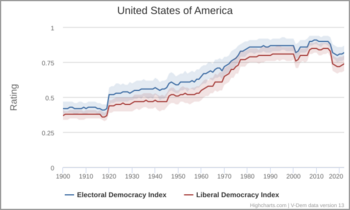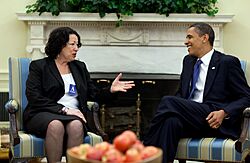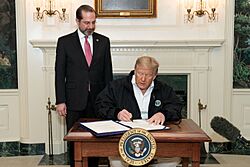History of the United States (2008–present) facts for kids
| 2008–present | |
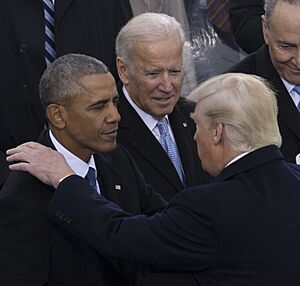
|
|
| Preceded by | History of the United States (1991–2008) |
|---|---|
| Including | War on Terror War on drugs Fourth Industrial Revolution COVID-19 Pandemic Migrations:
|
The history of the United States from 2008 to the present began with the collapse of the housing bubble, which led to the Great Recession. The resulting economic downturn and general discontent led Barack Obama to win the presidential election in 2008, becoming the country's first African-American president. Obama's domestic agenda notably included economic stimulus packages and the Affordable Care Act. The year 2011 saw the formal end to the Iraq War as well as the killing of Al-Qaeda leader Osama bin Laden. The War on Terror continued with a shift in attention toward the Islamic State in the 2010s.
Increased political polarization present during Obama's presidency led to a contentious presidential election in 2016 which saw businessman Donald Trump defeat former Secretary of State Hillary Clinton. Trump ran on a populist message, enacting tax cuts, immigration restrictions, attempting to "Build a Wall" on the US–Mexico border, and an "America First" foreign policy. In December 2019, the Democratic-controlled House of Representatives voted to pass articles of impeachment against Trump for his alleged role in a scandal involving Ukraine, for which he was subsequently acquitted. In the 2020 presidential election, Joe Biden defeated Trump, who, along with his supporters, made multiple attempts to dispute the 2020 United States presidential election, which included an attack on the United States Capitol on January 6, 2021. The attack and Trump's alleged involvement led to his second impeachment and subsequent acquittal. Biden has overseen the lasting effects of the COVID-19 pandemic as well as the end to the War in Afghanistan, end of the War on Terror, and the trade war with China.
Contents
Conflicts
War in Afghanistan
The War in Afghanistan continued. In September 2008, President Bush announced he would shift 4,500 US Armed Forces troops from Iraq to the conflict in Afghanistan. This was followed with recently elected President Barack Obama announcing in February 2009 that the United States would deploy an additional 17,000 troops to Afghanistan. The Obama administration also later announced a "troop surge" of an additional 30,000 US military forces to be deployed in the summer of 2010, and to begin withdrawals of the 100,000 total US troops in July 2011. With the surge in effect, the NATO-led International Security Assistance Force (ISAF) launched Operation Moshtarak, an offensive determined to eliminate Taliban insurgents from Helmand Province. At 15,000 troops, it was the largest joint operation of the war.

On May 1, 2011, President Barack Obama announced that the US conducted an operation that killed al-Qaeda leader Osama bin Laden at his compound in Abbottabad, Pakistan. The announcement drew worldwide praise, with spontaneous celebrations at Ground Zero, Times Square, and outside of the White House. The raid on bin Laden's compound in Abbottabad led to a rise in diplomatic tensions between the US and Pakistan. With civilian deaths from the United States' drone program in so-called "signature strikes", the 2011 NATO attack in Pakistan, which led to the deaths of 24 Pakistani military officers, and the closure of NATO supply lines to neighboring Afghanistan, Pakistan–United States relations remain fractured as a result of the War on Terror.
In mid-2011 Obama announced the start of the withdrawal of the additional 33,000 troops deployed from the 2010 troop surge. By December 2011, the first round of 10,000 troops were withdrawn, with the second round of 23,000 troops later withdrawn in September 2012.
As of February 2014, a total of 2,307 US troops were killed and 19,656 injured due to the Afghanistan War. Estimates from the Costs of Wars Project based at Brown University's Watson Institute for International Studies also suggest that between 16,725 and 19,013 Afghan civilians died as a result of the war.
The International Security Assistance Force ceased combat operations and was disbanded in December 2014, with a small number of troops remaining behind in an advisory role as part of ISAF's successor organization, the Resolute Support Mission. Unable to eliminate the Taliban through military means, coalition forces (and separately, the Afghan government led by Ashraf Ghani) turned to diplomacy to end the conflict.
Failing peace talks and the emergence of ISIS in the country caused the war to continue on into the Trump Administration. On February 25, 2019, negotiations began between the Taliban and the United States in Qatar and resumed again in December of that year. On February 29, 2020, the United States and the Taliban signed a conditional peace deal in Doha, Qatar, that called for a prisoner exchange within ten days and was supposed to lead to US troops withdrawal from Afghanistan by May 1, 2021.
On April 13, 2021, newly elected President Joe Biden announced his revised plan to withdraw all troops from Afghanistan by September 11, 2021, this date being the twentieth anniversary of the September 11 Attacks. The date for US troops to withdraw from Afghanistan was moved forward to August 31. The withdrawal of US soldiers and other foreign soldiers coincided with the 2021 Taliban offensive, where the Taliban defeated the Afghan Armed Forces culminating with the fall of Kabul on August 15, 2021. On the same day, the president of Afghanistan Ashraf Ghani fled to Tajikistan and the Taliban declared victory and the war had ended. Following a massive airlift of more than 120,000 people, the US military mission in Afghanistan ended on August 30, 2021.
Iraq War
As the situation in Iraq became increasingly difficult and deadly, policymakers began looking for new options. This led to the formation of the Iraq Study Group, a nonpartisan commission chaired by James Baker and Lee H. Hamilton. This produced a variety of proposals; some of the more notable ones were to seek decreased US presence in Iraq, increased engagement with neighboring countries, and greater attention to resolving other local conflicts, such as the Israeli–Palestinian conflict. The recommendations were generally ignored, and instead, President Bush ordered a surge of troops to Iraq in 2007 and 2008. Violence in the country declined in 2008 and 2009, and the US combat role ended in August 2010. US forces were withdrawn in large numbers in 2009 and 2010, and the war was declared formally over in December 2011.
Politics
Great Recession
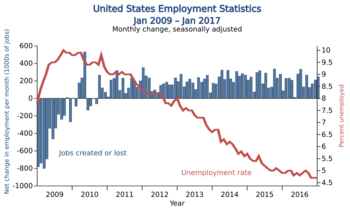
In 2007, while US unemployment dropped to its lowest level since the year 2000, the housing bubble reached its peak and economic growth slowed down, and by December 2007, the United States entered the severe long-lasting Great Recession. By mid-2008, property values and the values of other assets plummeted, and the stock market crashed in October 2008, spurred by a lack of investor confidence as the liquidity of assets began to evaporate. With the decline in wealth and the lack of investor and consumer confidence, growth and economic activity came to a screeching halt and the job growth of previous years was soon wiped out, with mass layoffs and unemployment rising rapidly in late 2008, and continuing into 2009.
Federal Reserve chairman Ben Bernanke told a federal commission in November 2009, "As a scholar of the Great Depression, I honestly believe that September and October of 2008 was the worst financial crisis in global history, including the Great Depression." Of the 13 most important US financial institutions, "12 were at risk of failure within a period of a week or two".
The Federal Reserve and the Treasury cooperated by pouring trillions into a financial system that had frozen up worldwide. They rescued many of the large financial corporations from bankruptcy – with the exception of Lehman Brothers, which went bankrupt – and took government control of insurance giant AIG, mortgage banks Fannie Mae and Freddie Mac, and both General Motors and Chrysler.
In October 2008, Bush sought, and Congress passed, the Emergency Economic Stabilization Act of 2008 (commonly referred to as the "bank bailout") with the goal of protecting the US financial system from complete collapse in the wake of the recession, which brought significant declines in the stock market. The bill provided federal government guarantees of up to $700 billion to troubled financial institutions through the Troubled Asset Relief Program (TARP). By 2010, only a fraction of that money was ever spent, as banks were able to quickly repay loans from the federal government or ended up never needing the money.
Meanwhile, unemployment doubled to nearly 10%, with states such as California and Michigan especially hard hit. While the stock market rebounded by 2011, and corporate profits had recovered, unemployment remained over 9% into 2011. The recession was worldwide, with Europe and Japan hard hit, while China, India and Canada fared much better.
Democratic backsliding
Scholars and historians of democracy identified a democratic backsliding in the United States since the late 2010s. The V-Dem Democracy indices's electoral democracy index score for the United States peaked in 2015 and declined sharply after 2016, for which year it was also downgraded to "flawed democracy" by the Economist Intelligence Unit in its annual Democracy Index report. Both V-Dem and Freedom House downgraded the United States in 2018. According to James Grumbach, beyond the national level, democratic backsliding has occurred in American states under unified Republican Party control while Democratic Party-controlled and divided states have become more democratic. Grumbach also states "policies are more varied across the states as red and blue party coalitions implement increasingly distinct agendas."
Obama administration
The nation went into the 2008 election cycle having a Republican president and Democratic Congress both with extremely low approval ratings. New York Senator Hillary Clinton had the inside track for the nomination but faced an unexpected challenge from Barack Obama, the nearly unknown junior Senator from Illinois. The GOP nominated Arizona Senator John McCain. During the general election, Obama's youthfulness, charisma, and widespread media support proved effective against McCain, seen as a stodgy Washington insider. In addition, his relatively advanced age (72) and injuries from captivity in the Vietnam War drew doubts over his health and stamina. Overall disillusionment with the Republican Party and George Bush's administration did not help McCain's cause, and his choice of Alaska governor Sarah Palin as his running mate also drew some controversy. Obama also drew some doubts over his inexperience and controversial associations with Weather Underground founder William Ayers and Reverend Jeremiah Wright, the pastor of an African-American church Obama had attended for years who was discovered to have made anti-white sermons. The decisive event was the collapse of the national financial system over the summer, launching a severe worldwide depression. On November 4, 2008, Obama defeated McCain 365 to 173 in the electoral vote and 52.9% to 45.7% in the popular vote to become the 44th president of the United States, making history in becoming the first African American to be elected to the highest executive office. Part of the strong showing came from a surge of support from younger voters, African Americans, Hispanics and independents. Democrats made further gains in Congress, adding to the majorities they had won in 2006.
Obama's early policy decisions addressed a continuing global financial crisis and have included changes in tax policies, foreign policy initiatives and the phasing out of detention of prisoners at the Guantanamo Bay detention camp in Cuba. Within a few weeks of taking office, the new president and Congress passed the American Recovery and Reinvestment Act of 2009, which was ostensibly aimed at recovering from the economic collapse. This entailed a $700 billion stimulus package for the economy, although there were considerable questions over the amount of money spent or its actual effectiveness.
A domestic initiative passed by the 111th Congress and signed into law by President Obama was the Affordable Care Act, an important statute guaranteeing comprehensive medical coverage to all Americans, regardless of age, sex, pre-existing health conditions or ability to pay. The Don't Ask, Don't Tell Repeal Act, which allowed openly gay people to serve in the military, was enacted in 2010.
In foreign policy, President Obama withdrew US troops from Iraq in large numbers, bringing the Iraq War to an end in December 2011. At the same time, he also increased troop levels in the Afghanistan War. Early in his presidency, he successfully negotiated the New START treaty with the Russian Federation, which made significant reductions in their nuclear arsenals. The US also maintained ongoing talks, led by Secretary of State Hillary Clinton, with North Korea over its nuclear weapons program, as well as with Israel and the Palestinian Authority over a two-state solution to the Israeli–Palestinian conflict. In May 2011, President Obama announced in a televised speech to the nation that al-Qaeda leader and culprit behind many deadly acts of terrorism (including the September 11 attacks) Osama bin Laden was killed by US forces at a compound in Abbottabad, Pakistan.

Although the recession reached its bottom in June 2009 and began to move up again, voters remained frustrated with the slow pace of the economic recovery. In the spring of 2009, large protests erupted in Washington, DC from conservative groups who began calling themselves the "Tea Party" and who were particularly opposed to the controversial stimulus act. The Tea Party would end up in a few years as a springboard for a large-scale Republican revival. In the 2010 midterms, the GOP retook control of the House, although the Senate remained in Democratic hands.
Under the new Congress, which had a Republican House and a Democratic Senate, President Obama and Congress clashed for months over whether or not to raise the debt ceiling and whether or not to extend the payroll tax cuts for middle-income citizens that Obama signed into law. After months of heated debate, the debt ceiling was ultimately raised and the tax cuts extended. However, Obama's approval ratings continued to hover at around 46%, while Congress had an even lower approval rating of 11%.
In the 2012 presidential election, the GOP nominated former Massachusetts governor Mitt Romney. Much like John McCain four years earlier, Romney was largely seen as a tepid moderate and a Beltway insider who did not inspire the conservative base of the Republican Party, nor independents. He also drew controversy for his stand on Obamacare, which had been based on the system he implemented as Governor of Massachusetts. Obama defeated his opponent to win a second term, with a tally in the Electoral College by 332 to 206 and in the popular vote by 51.06% to 47.21%. The electoral map remained the same as 2008, with the exception of North Carolina and Indiana flipping back as red states, and the party balance in Congress remained largely unchanged.
In the November 2014 midterm elections, the Republican Party took control of the Senate and expanded its majority in the House of Representatives, an event that portended an ill omen for the Democrats.
On December 17, 2014, President Barack Obama announced a restoration of full diplomatic relations with Cuba for the first time since 1961. A deal between the United States and Cuba was brokered during 18 months of secret talks hosted by Canada, with a final meeting hosted by Pope Francis at the Vatican. Although the US embargo remains in effect and ordinary tourism by Americans is still prohibited, the United States will ease travel restrictions, release three Cuban spies, and open an embassy in Havana.
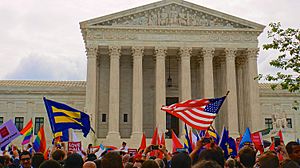
On June 26, 2015, the Supreme Court ruled, 5–4, in the case of Obergefell v. Hodges that same-sex marriage was a constitutionally protected right under the 14th Amendment. Shortly before the ruling, polling showed the majority of Americans approving of same-sex marriage.
In regards to the Supreme Court, President Obama faced three vacancies during his administration. Justice David Souter retired in June 2009 and the president nominated as his replacement Sonia Sotomayor, the first Hispanic Supreme Court Justice in US history. Justice John Paul Stevens retired exactly one year later and Obama replaced him with Elena Kagan. Justice Antonin Scalia died on February 13, 2016. President Obama nominated Merrick Garland as his replacement, but the United States Senate, led by Republican Majority Leader Mitch McConnell refused to give Garland a hearing, instead arguing that the winner of the ongoing presidential election be given the opportunity to nominate Scalia's replacement instead. Justice Ruth Bader Ginsburg was pressured by liberal groups to retire while the Democrats remained in control of the White House, but declined to do so.
On September 25, 2015, John Boehner announced that he would step down as Speaker and resign from Congress at the end of October 2015. Boehner's resignation took place after Pope Francis' address to Congress the day before, an event considered by Boehner as a high point in his legislative career. Boehner was replaced by Republican Paul Ryan, the US representative for Wisconsin's 1st congressional district and former candidate for vice president along with Mitt Romney.
Trump administration
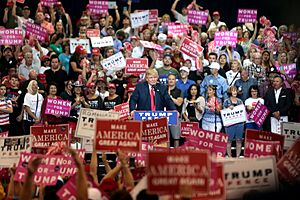
In the 2016 presidential election, the GOP had 17 candidates. The Democratic Party had fewer potential candidates to choose from, and the campaign early on centered on Hillary Clinton, former Secretary of State, United States Senator from New York, and First Lady of the United States. A surprise challenger to Clinton appeared in 74-year-old Vermont Senator Bernie Sanders, a self-identified democratic socialist and the one of only two independents in the Senate. Despite attracting a large, enthusiastic following among mostly young voters, Sanders was unable to secure the nomination. When the primary season finished in the spring, Clinton secured the Democratic nomination. Senator Bernie Sanders finally conceded the race, endorsing then presumptive nominee Hillary Clinton.
Meanwhile, in June 2015, real estate mogul Donald Trump announced that he was seeking the presidency. Although Trump's announcement received little attention at first (he had mounted a short-lived third-party presidential run in 2000), he quickly bounded out of the gate with a populist message about his perceived decline of American economic and geopolitical prestige under the previous two administrations. By the start of the primary season in early 2016, Trump was polling ahead of the other GOP candidates despite his lack of political experience and attracting a considerable following among the party base. By the spring of 2016, most GOP candidates had dropped out of the running and Trump had no remaining challengers other than Ted Cruz and John Kasich. Some right wing conservatives and Christian groups continued to support Cruz, especially as there was controversy over Trump's personal life and relatively liberal attitude on social issues. However, Trump's economic message had widespread populist appeal and on May 3, Ted Cruz officially ended his presidential campaign. John Kasich followed suit the following day. As the primaries gave way to the general election, Hillary Clinton faced numerous controversies over her tenure as Secretary of State. Polls and surveys showed that both Clinton and Trump had an overall negative image among voters. Meanwhile, Donald Trump chose as his running mate Indiana Governor Mike Pence.
On Election Day, November 8, Trump carried 306 electoral votes against Clinton's 232. He made considerable inroads into the old Rust Belt, carrying states such as Michigan, Wisconsin and Pennsylvania that had been safe Democratic territory since 1988. However, Donald Trump did not win the popular vote. This was the fifth time in American history that the outcome of the Electoral College did not match the outcome of the popular vote, the others happening in 1824, 1876, 1888, and 2000. The GOP also retained control a majority in both the House of Representatives and the Senate, controlling all branches of government. Allegations of Russian interference on behalf of Trump's candidacy in the 2016 election caused controversy during and after the election.
On January 20, 2017, Trump took the oath of office as the 45th US president in the face of large-scale demonstrations from protesters unhappy with the outcome of the election and of the incoming president. On his first day in office, he undertook a series of executive orders aimed at dismantling the Affordable Care Act and Trans-Pacific Partnership, and also moved to pass a temporary ban on refugees from several Middle Eastern states. This last action met with widespread criticism, and the 9th Circuit Court of Appeals dismissed it as unconstitutional. On June 26, the Supreme Court overturned the 9th Circuit's decision, ruling that part of President Trump's executive order is constitutional. One of Trump's major accomplishments was nominating Associate Justice Neil Gorsuch to the Supreme Court. On April 10, Gorsuch was sworn in. In 2018, President Trump nominated Brett Kavanaugh to replace the departing Associate Justice Anthony Kennedy.

In December 2017, Congress passed and President Trump signed into law the Tax Cuts and Jobs Act of 2017. The Act amended the Internal Revenue Code of 1986 based on tax reform advocated by congressional Republicans and the Trump administration. Major elements include reducing tax rates for businesses and individuals; a personal tax simplification by increasing the standard deduction and family tax credits, but eliminating personal exemptions and making it less beneficial to itemize deductions; limiting deductions for state and local income taxes (SALT) and property taxes; further limiting the mortgage interest deduction; reducing the alternative minimum tax for individuals and eliminating it for corporations; reducing the number of estates impacted by the estate tax; and repealing the individual shared responsibility provision of the Affordable Care Act (ACA). The nonpartisan Congressional Budget Office (CBO) reported that, under the Act, individuals and pass-through entities like partnerships and S corporations would receive about $1,125 billion in net benefits (i.e. net tax cuts offset by reduced healthcare subsidies) over 10 years, while corporations would receive around $320 billion in benefits. The individual and pass-through tax cuts fade over time and become net tax increases starting in 2027 while the corporate tax cuts are permanent. This enabled the Senate to pass the bill with only 51 votes, without the need to defeat a filibuster, under the budget reconciliation process. Tax cuts were reflected in individual worker paychecks as early as February 2018 and with the corporate tax rate being reduced from 35% to 21%, numerous major American corporations announced across-the-board pay raises and bonuses for their workers, expanded benefits and programs, and investments in capital improvements.
Trump announced plans to withdraw the United States from the Paris Climate Agreement in June 2017. The agreement prevented any country from leaving less than three years after it began, so the United States had to wait until November 4, 2019, to officially start the withdrawal process. After a mandatory one-year waiting period, the country left on November 4, 2020.
On May 9, 2018, the Trump Administration withdrew from the Joint Comprehensive Plan of Action (JCPOA) (also known as the Iran Nuclear Deal) with Iran, and other Great Powers, over alleged violations of the agreement by the Iranians in regards toward their nuclear program.
The effects of the tax cuts resulted in the US economy stabilizing for a short period between early 2018 and September 2019. During that time, the 2018 midterm elections took place. The elections had the highest voter turnout of any midterm election since 1914; the Democratic Party regained majority control of the House of Representatives and the Republican Party expanded their majority in the Senate even though they received a minority of the popular vote.
In October 2019, the Federal Reserve announced that it would conduct a repurchase agreement operation to provide funds in the repo markets after the overnight lending rates spiked well above the Fed's target rate during the week of September 16.
At that time, the United States began to feel the effects of a global synchronized economic slowdown that began after global growth peaked in 2017 and industrial output started to decline in 2018. The International Monetary Fund blamed 'heightened trade and geopolitical tensions' as the main reason for the slowdown, citing Brexit and the China–United States trade war as primary reasons for slowdown in 2019, while other economists blamed liquidity issues.
On December 18, 2019, the House of Representatives brought forth two articles of impeachment (abuse of power and obstruction of Congress) against President Trump. Both articles were passed, impeaching Trump. Trump became the third president in American history to be impeached, after Andrew Johnson and Bill Clinton.
On December 20, 2019, Trump signed the 2020 National Defense Authorization Act, establishing the United States Space Force as the sixth armed service branch, with Air Force General John "Jay" Raymond, the head of Air Force Space Command and US Space Command, becoming the first Chief of Space Operations.
On January 3, 2020, President Trump responded to an attack on the US Embassy in Baghdad by ordering a drone strike against the Islamic Revolutionary Guard Corps's commanding general Qasem Soleimani and the Popular Mobilization Forces leader Abu Mahdi al-Muhandis at Baghdad International Airport. The incident sharply escalated a period of already strong tensions with Iran and lead to missile strikes on US military forces in Iraq on January 8, 2020. At the same time, Iranian military forces mistakenly shot down Ukraine International Airlines Flight 752, leading to domestic unrest and international condemnation.
In June 2020, the Supreme Court ruled against the Trump administration's order to rescind Deferred Action for Childhood Arrivals (DACA), saying the administration had not provided adequate reasoning under the Administrative Procedure Act. DACA is a United States immigration policy that allows some individuals with unlawful presence in the United States after being brought to the country as children to receive a renewable two-year period of deferred action from deportation and become eligible for a work permit in the US. To be eligible for the program, recipients cannot have felonies or serious misdemeanors on their records. Unlike the proposed DREAM Act, DACA does not provide a path to citizenship for recipients.
In September 2020, the death of Associate Justice Ruth Bader Ginsburg prompted President Trump to nominate Amy Coney Barrett to fill the Supreme Court vacancy. The Senate voted to confirm Barrett in a partisan vote.

President Trump lost the 2020 presidential election to Joe Biden, who previously served as Vice President under President Barack Obama. He became the first president to lose the popular vote in both elections contested, as well as the first president since George H. W. Bush's loss in 1992 to be defeated after his single term. Biden himself became the oldest person to win a United States presidential election and was the oldest president upon his inauguration. The election also saw Kamala Harris become the first woman, as well as first person of African-American and Asian-American ancestry, to be elected as Vice President.
Donald Trump and his allies attempted several efforts to overturn the election results and remain in office, none of which were successful. During the counting of electoral votes on January 6, the United States Capitol was attacked by supporters of Trump following a rally in support of his presidency. In the final days of his presidency, Trump was impeached for a second time due to his role in the attack, although he was acquitted by the Senate after leaving office. Trump was later indicted in August 2023 over his role, as well as for other criminal proceedings including his mishandling of classified documents and hush money payments.
Biden administration
Joe Biden was inaugurated on January 20, 2021. He is the oldest president at his inauguration at 78 years old beating his predecessor Donald Trump's record of 70. His vice president, Kamala Harris, was elected alongside Biden and is the first female vice president in American history.
On the first day of his presidency, Biden made an effort to revert President Trump's energy policy by restoring U.S. participation in the Paris Agreement and revoking the permit for the Keystone XL pipeline. He also halted funding for Trump's border wall, an expansion of the Mexican border wall. On his second day, he issued a series of executive orders to reduce the impact of COVID-19, including invoking the Defense Production Act of 1950, and set an early goal of achieving one hundred million COVID-19 vaccinations in the United States in his first 100 days.
Biden signed into law the American Rescue Plan Act of 2021; a $1.9 trillion stimulus bill that temporarily established expanded unemployment insurance and sent $1,400 stimulus checks to most Americans in response to continued economic pressure from COVID-19. He signed the bipartisan Infrastructure Investment and Jobs Act; a ten-year plan brokered by Biden alongside Democrats and Republicans in Congress, to invest in American roads, bridges, public transit, ports and broadband access. He appointed Ketanji Brown Jackson to the U.S. Supreme Court—the first Black woman to serve the court. Biden proposed a significant expansion of the U.S. social safety net through the Build Back Better Act, but those efforts, along with voting rights legislation, failed in Congress. However, in August 2022, Biden signed the Inflation Reduction Act of 2022, a domestic appropriations bill that included some of the provisions of the Build Back Better Act after the entire bill failed to pass. It included significant federal investment in climate and domestic clean energy production, tax credits for solar panels, electric cars and other home energy programs as well as a three-year extension of Affordable Care Act subsidies. From June 2022 until the loss of Democratic control of the House following the 2022 midterm elections, Biden went on a string of legislative achievements including: the Bipartisan Safer Communities Act; the CHIPS and Science Act, a massive investment in the semiconductor industry and manufacturing; Honoring our PACT Act of 2022, expansion of veterans healthcare; and the Respect for Marriage Act, repealing the Defense of Marriage Act and codifying same-sex and interracial marriage.
In foreign policy, Biden completed the withdrawal of U.S. military forces from Afghanistan, declaring an end to nation-building efforts and shifting U.S. foreign policy toward strategic competition with China and, to a lesser extent, Russia.
House Speaker Kevin McCarthy (R-CA) was ousted from his position on October 3, 2023, marking the first time a Speaker of the House in US history had been voted out. A new Speaker, Mike Johnson, a Republican representative from Louisiana, was elected on October 25 after several weeks of debate about who the new speaker should be.
Donald Trump announced his intention to run for the 2024 United States presidential election on November 22, 2022 with Joe Biden announcing his intent to run in the 2024 presidential election on April 25, 2023. Both President Biden and Donald Trump became the presumptive nominees for their respective parties on March 12, 2024. During the campaign, Trump was found guilty in court of falsifying 34 counts of business records relating to this 2016 campaign on May 31 making him the first former US President to be convicted of a felony crime.
Societal trends
Religion
A 2014 Religious Landscape Study conducted by Pew Research Center from June 4 to September 30, 2014, found Christianity declined 7.8% from 78.4% in 2007 to 70.6% in 2014, unaffiliated rose 6.7% from 16.1% in 2007 to 22.8% in 2014, and non-Christian religions rose 1.2% from 4.7% in 2007 to 5.9% in 2014.
Technology
The usage of the internet grew during this time period. A Pew Research Center factsheet from 2021 noted that the number of adults using the internet in 2008 was 74% while in 2021 it had increased to 93%. The number of people using the internet grew during this period going from 226.21 million in 2008 to 305.37 million in 2020. 2008 would mark the first time that the country with the most internet users (the number of people who use the internet) was not the United States as China surpassed the country that year. India would surpass the United States in 2019.
Internet based services that had their debuts were such as: Uber (originally known as UberCab until rebranding in October 2010) in June 2010 which initially operated in San Francisco, and Airbnb in 2008. Social media platforms from or based in the United States that launched included: Instagram in October 2010 and TikTok launching in the United States in August 2018 which is owned by the private Chinese company ByteDance. With the introduction of TikTok, concern would arise about security and censorship. A bill was signed into law on April 24, 2024 requiring ByteDance to sell TikTok within a year or be banned.
Other technological trends
There was a decline in television viewership during this period. A Pew Research Center poll from 2021 reported that in 2015, 76% of American adults received TV via satellite or cable while in 2021 this had declined to 56%. This decline in cable and satellite TV viewership has been attributed to the COVID-19 pandemic and the growth of internet streaming platforms. The usage of landline phones would decline while the increase of wireless phones would increase. The percentage of American adults having wireless instead of landline would be surpassed in December 2008 and the percent of homes being solely wireless would surpass those having both wireless and landline in June 2015.
Travel and transportation
The 2020 US Census Bureau Community Survey found 91.5% of households had access to at least one car which was a gain from 90.982% in 2015. During the 2010s the number of passengers grew on US airlines on both domestic and international flights consecutively. The COVID-19 pandemic led to a dramatic decline in the number of airline passengers going from its peak during this period of 926.44 million passengers in 2019 to a low of 369.69 million in 2020. In the following years the number of passengers on US airlines begun to recover. International travel would end up fully recovering from the downturn in international travel because of the COVID-19 pandemic in 2023 with peak numbers being reached by July of that year.
Space exploration
In terms of space exploration numerous events occurred. The Space Shuttle program would be retired in 2011 doing its final flight that year. Voyager 1, launched in 1977 by NASA became the first spacecraft to enter interstellar space in 2012. While Voyager 2 (also launched in 1977 by NASA) entered interstellar space in 2018 becoming the second spacecraft to do so. The first flyby of Pluto ever was done by NASA's New Horizons probe in 2015. The Dawn space probe launched by NASA in 2007 visited the asteroid Vesta in 2011 being the first spacecraft to orbit an asteroid before later leaving next year to visit the dwarf planet Ceres entering its orbit in 2015. Dawn would be the first space craft to visit and orbit a dwarf planet. For the first time since the final Apollo program mission to the Moon in 1972 an American craft, IM-1 would land on the Moon on February 22, 2024. Not only that but it was also the first commercial landing on the Moon in history.
Recreation and leisure
The number of visitors to National Parks would increase and decrease throughout the 2010s. An all time peak of visitors to National Parks occurred in 2016 with 330.971 million recreational visits being made. Four new National Parks were created during the 2010s: White Sands, Indiana Dunes, Gateway Arch and Pinnacles National Park while another; New River Gorge in West Virginia was created in 2020.
The number of memberships at fitness centers/health clubs in the United States declined between 2008 and 2009 before increasing once again between 2010 and 2011 when it declined in 2012. After 2012 and until the end of the decade the number begun to increase each year. The Outdoor Foundation reported that for 2020 a record 53% of Americans who were 6 years and older participated in some form of outdoor recreation at least once despite the COVID-19 pandemic. The most outdoor activity was "running, jogging and trail running" with 21% of Americans reporting they did so.
Disasters
Natural disasters
In the spring of 2011, several major tornado outbreaks affected the Central and Southern United States. Forty-three people were killed in a tornado outbreak from April 14–16. Approximately 350+ people were killed in a tornado outbreak from April 25–28, the deadliest US tornado outbreak in 75 years (since the 1936 Tupelo-Gainesville tornado outbreak). States particularly hit hard by the outbreaks included Oklahoma, Arkansas, Mississippi, Tennessee, Georgia, North Carolina, Virginia, and most especially, Alabama, which sustained over 250 fatalities alone. The latter outbreak produced $10 billion in damage, making it the costliest tornado outbreak in history. On May 22, an EF5 tornado devastated Joplin, Missouri, killing 154, injuring over 1,000 people, and causing $1–3 billion in damage, making it the deadliest single US tornado in 64 years and the costliest single tornado of all time.
In August 2011, Hurricane Irene was the first hurricane to make landfall since Ike in 2008, striking the Eastern Seaboard of the United States, making landfalls in North Carolina, New Jersey, and New York. The storm killed at least 45 people and caused $10 billion in damage. The storm was particularly notable for its extensive flooding in the Northeast, and a couple days later, Tropical Storm Lee made landfall in Louisiana, its remnants tracking to the Northeast for even more devastating floods.
In October 2012, Hurricane Sandy struck the East Coast of the United States, making landfall near Atlantic City, New Jersey. The storm knocked out power to millions of people and caused flooding in parts of New York City along with devastation to the Jersey Shore and portions of Long Island and Staten Island. The storm has been blamed for 121 fatalities and is estimated to have caused at least $50 billion in damage.
In May 2013, at least 24 people were killed, 377 people were injured, and $1.5 to $3 billion in damage was caused when an EF5 tornado struck the Oklahoma City suburb of Moore, which was hit by a deadly and destructive F5 tornado only 14 years prior.
In August 2017, Hurricane Harvey became the first major hurricane to make landfall in the United States since Hurricane Wilma in 2005. It devastated Houston, Texas, causing extreme flooding, 83 confirmed deaths, and an estimated $70 billion to $200 billion in damage. Harvey's highest winds hit 130 mph.
In September, Hurricane Irma hit Florida, killing 102 people and causing over $62.87 billion in damage, making it unofficially the fourth-costliest hurricane on record. The size of the storm spanned across the entire Florida peninsula, and all 67 counties of Florida declared a state of emergency. Irma's highest winds were 185 mph. Later that month, Hurricane Maria hit Puerto Rico, a US territory, killing over 547 people and causing over $91.6 billion in damage, making it the third-costliest Atlantic hurricane on record. Maria's highest winds were 175 mph.
On September 14, 2018, Hurricane Florence hit North Carolina as a Category 1 Hurricane, causing major flooding. 39 deaths were counted and damage is estimated as $17 billion (2018 USD). Florence's highest winds were 140 mph. On October 10, Hurricane Michael struck the Florida Panhandle as a Category 5 storm with 160 mph winds after undergoing rapid intensification just prior to landfall; it killed 45 people in the US and caused $15 billion in damage.
In November of that year, several wildfires devastated portions of California, most notably the Camp Fire in Butte County in Northern California, which burned over 150,000 acres and destroyed nearly 19,000 structures. With a death toll of 86 and damages up to $10 billion, it was the deadliest and most destructive wildfire in California history and the deadliest US wildfire since 1918.
A series of earthquakes struck Southern California on July 4 and 5, 2019. A magnitude 6.4 earthquake, a foreshock, struck near the desert city of Ridgecrest, on July 4. On July 5, a 7.1 earthquake struck, the main shock, centered near the first. The latter was the largest earthquake to hit Southern California in 20 years. Relatively minor damage resulted from the initial foreshock, though some building fires were reported in Ridgecrest near the epicenter. Effects were felt across much of Southern California as well as parts of Arizona and Nevada, as far north as the San Francisco Bay Area and Sacramento, and as far south as Baja California, Mexico. An estimated 20 million people experienced the foreshock, and approximately 30 million people experienced the mainshock.
In early August 2023, a series of wildfires broke out in the U.S. state of Hawaii, predominantly on the island of Maui. The wind-driven fires prompted evacuations, caused $5.5 billion in damages, killing at least 100 people and leaving at least 31 others missing in the town of Lahaina, Hawaii.
See also
- Presidency of George W. Bush
- Presidency of Barack Obama
- Presidency of Donald Trump
- Presidency of Joe Biden
- Outline of United States history
- Timeline of the history of the United States (1990–2009)
- Timeline of the history of the United States (2010–present)
- Timeline of modern American conservatism
- List of federal political scandals in the United States
- Category:2000s in the United States
- Category:2010s in the United States
- Category:2020s in the United States


